History of archery
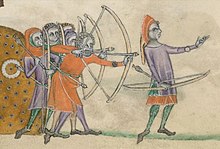
Archers were a widespread if supplemental part of the military in the classical period, and bowmen fought on foot, in chariots or mounted on horses. Archery rose to prominence in Europe in the later medieval period, where victories such as the Battle of Agincourt cemented the longbow in military lore.[citation needed]
Archery in both hunting and warfare was eventually replaced by firearms in Europe in the Late Middle Ages and early modern period. Firearms eventually diffused throughout Eurasia via the Gunpowder empires, gradually reducing the importance of archery in warfare throughout the world.[citation needed]
Archery is still practiced today, for hunting[2] and as a target sport.[citation needed]
Prehistory
Paleolithic and Epipaleolithic
The oldest known evidence of arrows comes from South African sites such as Sibudu Cave, where likely arrowheads have been found, dating from approximately 72,000–60,000 years ago,[3][4][5][6][7][8] on some of which poisons may have been used.[3]
Small stone points from the
Likely arrowheads were reported in 2020 from Fa Hien Cave in Sri Lanka, dated to 48,000 years ago. "Bow-and-arrow hunting at the Sri Lankan site likely focused on monkeys and smaller animals, such as squirrels... Remains of these creatures were found in the same sediment as the bone points."[12][13]
At the site of Nataruk in Turkana County, Kenya, obsidian bladelets found embedded in a human skull and within the thoracic cavity of another human skeleton, suggest the use of stone-tipped arrows as weapons about 10,000 years ago.[14]
In the Sahara, Mesolithic rock art of the Tassili plateau from 5,000 BP or earlier depicts people carrying bows.[15]
Based on indirect evidence, the bow seems also to have appeared or reappeared later in Eurasia around the Upper Paleolithic.
In the
Possible fragments of a bow found at Mannheim-Vogelstang have been dated to the Early Magdelenian age (c. 17,500 to 18,000 years ago) and at Stellmoor dated 11,000 years ago.[16] Azilian points found in Grotte du Bichon, Switzerland, alongside the remains of both a bear and a hunter, with flint fragments found in the bear's third vertebra, suggest the use of arrows at 13,500 years ago.[17]
Other early indications of archery in Europe come from Stellmoor in the Ahrensburg valley north of Hamburg, Germany. They were associated with artifacts of the late Paleolithic (11,000–9,000 BP). The arrows were made of pine and consisted of a mainshaft and a 15–20 centimetre (6–8 inches) long foreshaft with a flint point. They had shallow grooves on the base, indicating that they were shot from a bow.[18]
The oldest definite bows known so far come from the Holmegaard swamp in Denmark. In the 1940s, two bows were found there, dated to about 8,000 BP.[19] The Holmegaard bows are made of elm and have flat arms and a D-shaped midsection. The center section is biconvex. The complete bow is 1.50 m (5 ft) long. Bows of Holmegaard-type were in use until the Bronze Age; the convexity of the midsection has decreased with time.

The oldest depictions of combat, found in Iberian cave art of the Mesolithic, show battles between archers.[20] A group of three archers encircled by a group of four is found in Cueva del Roure, Morella la Vella, Castellón, Valencia. A depiction of a larger battle (which may, however, date to the early Neolithic), in which eleven archers are attacked by seventeen running archers, is found in Les Dogue, Ares del Maestrat, Castellón, Valencia.[21] At Val del Charco del Agua Amarga, Alcañiz, Aragon, seven archers with plumes on their heads are fleeing a group of eight archers running in pursuit.[22]
Archery seems to have arrived in the Americas via Alaska, as early as 6000 BC,
Neolithic
The oldest Neolithic bow known from Europe was found in anaerobic layers dating between 7,400 and 7,200 BP, the earliest layer of settlement at the lake settlement at La Draga,
Bronze Age
Ancient history

North Africa
The ancient Egyptian people took to archery as early as 5,000 years ago. It was widespread by the time of the earliest pharaohs and was practiced both for hunting and use in warfare. Legendary figures from the tombs of Thebes are depicted giving "lessons in archery".[31] Some Egyptian deities are also connected to archery.[32] The "Nine bows" were a conventional representation of Egypt's external enemies. One of the oldest representations of the Nine bows is on the seated statue of Pharaoh Djoser (3rd Dynasty, 27th century BC).[33] Many of the archers in service to Egypt were of
Mesopotamia
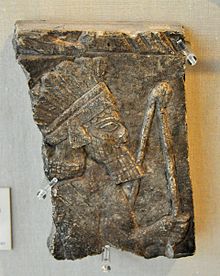
The Assyrians and Babylonians extensively used the bow and arrow for hunting and warfare. The empires in ancient Mesopotamia formed the first standing armies used exclusively for warfare. This included soldiers trained and employed as archers. The archers served as an integral division of the military that was used on foot and on chariots.

The Chariot warriors of the Kassites relied heavily on the bow. The Nuzi texts detail the bows and the number of arrows assigned to the chariot crew. Archery was essential to the role of the light horse-drawn chariot as a vehicle of warfare.[34]
The
Three-bladed (trilobate) arrowheads have been found in the United Arab Emirates, dated to 100 BC-150 AD.[35]
Eurasian Steppes
The
Domestication of horses and mounted horseback archery are also believed to have originated in the Eurasian steppes. This revolutionized warfare as well as the practice of archery.
India
The use of bow and arrow was recorded extensively throughout the history of the Indian subcontinent.
The paleolithic paintings of Bhimbetka rock shelters depict archery.[36] Vedic hymns in the Rigveda, Yajurveda, and Atharvaveda lay emphasis on the use of the bow and arrow.[37] The second Veda, the Yajurveda contains Dhanurveda (dhanus "bow" and veda "knowledge"), which was an ancient treatise on the science of archery and its use in warfare. The existence of Dhanurveda or "Science of Archery" in antiquity is evident from references made in several works of ancient literature. The Viṣṇu Purāṇa refers it as one of the eighteen branches of knowledge taught, while the Mahābhārata mentions it as having sutras like other vedas. Śukranīti describes it as that 'upaveda of yajurveda' which has five arts or practical aspects. The Dhanurveda enumerates the rules of archery, and describes the uses of weapons and the training the army. Besides providing the account of the training of the archers, Vasiṣṭha's Dhanurveda describes the different types of bows and arrows, as well as the process of making them. Detailed accounts of training methodologies in early India considered to be an essential martial skill in early India.[38]
The composite bow in India was being used by 2nd millennium BCE. The bow was used extensively on foot as well on chariots. It was incorporated into the standing armies of the Mahajanapadas, and used in mounted warfare on horses, camels, and elephants with a howdah. The importance of archery continued through antiquity during the Maurya Empire. The Arthashastra, a military treaties written by Chanakya during the Maurya Era, goes in depth on the importance and implementation of archery. It also mentions an archery school at Taxila which enrolled 103 princes from different kingdoms across the empire.
During the era of the Gupta Empire mounted archery was largely supplanted by foot archers. This was in contrast to the nomadic armies on horseback from Central Asia such as the Iranian, Scythians, Parthians, Kushans, and Hunas. Later Indian kingdoms entities would maintain and field large numbers of mounted archers. The use of bows and arrows continued to be used as the mainstay of most Indian armies until the advent of firearms, introduced by Mongol gunpowder empires.[34][39]
Greco-Roman antiquity

The people of Crete practiced archery and Cretan mercenary archers were in great demand.[40] Crete was known for its unbroken tradition of archery.[41]
During the invasion of India by Alexander the Great, archers are listed among the troops Alexander personally commanded.[42]
The early Romans had very few archers, if any. As their empire grew, they recruited auxiliary archers from other nations.
East Asia

Archery featured prominently in ancient Chinese culture and philosophy
Medieval history
Europe
At the start of the medieval period, shortbows were used for both hunting and warfare. Medieval shortbows were structurally similar to ancient bows, but new construction materials significantly increased their usefulness. With a range of about 100yds a shortbow had the ability to kill or injure an unarmoured man at close range, but were often ineffective against armour.
Around the tenth century the crossbow was introduced in Europe. Crossbows generally had a longer range, greater accuracy and more penetration than the shortbow, but suffered from a much slower rate of fire. Unlike the longbow they did not require special skill or strength to use effectively. They were also controversial, attracting stigma to those who used them, and were outlawed by the Lateran Council of 1139.[50] Despite this, crossbows were used in the early Crusades, with models having a range of 300 yd (274 m) and being able to penetrate armour or kill a horse.[51] They fired short metal bolts rather than arrows. The French army relied substantially on the crossbow in late medieval times.[52]
The
The Middle East
In the Middle East the composite bow was the preferred bow in the later Medieval period. More powerful than the shortbow, they had the advantage over the longer longbow that they could be fired from horseback. However they also required skilled craftsmen to manufacture, and, like the longbow, extensive training to use well. The Byzantine Empire was already using mounted archers extensively by the 5th Century, and the Emperor Mavrikios laid down principles for their use in his seminal military work the Strategikon of Maurice. The core of the Byzantine army was the Cataphract, an armoured horse archer. The Byzantines also recruited mercenary light mounted archers from the Steppes.[55]
Turkish tribes, of which the
Asia
The
In Korea Joseon adopted a military-service examination system from China that included a focus on archery skills and that contributed to the development of Korean archery as a practical martial art.[58]
In Asia archery was one of the Six Noble Arts of the Zhou dynasty of China (1146–256 BC); archery skill was a virtue for Chinese emperors.[45][46]

The
A complete arrow of 75 cm[60] (along with other fragments and arrow heads) dated back to 1283 AD, was discovered inside a cave[61] situated in the Qadisha Valley, Lebanon.[62]
A treatise on
A treatise on Saracen archery was written in 1368. This was a didactic poem on archery dedicated to a Mameluke sultan by Ṭaibughā al-Ashrafī.[64]
A 14th-century treatise on Arab archery,
A treatise, A book on the excellence of the bow & arrow of c. 1500 details the practices and techniques of archery among the Arabs of that time.[66]
An anonymous book written in Picardy, France, in the late 15th century details how archery in medieval Europe was practiced. The book was titled Le Fachon de tirer l'arc a main. It describes the means of how a yew bow could be made, the kinds of wood that could be used, how to shoot it, string it and different kind of arrows. According to the writer, its purpose is for posterity, possibly due to the rise of the gun.[67]
In
Decline of archery
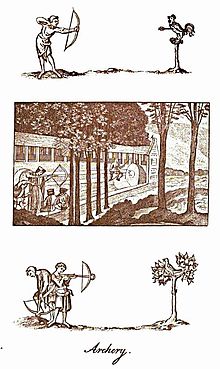
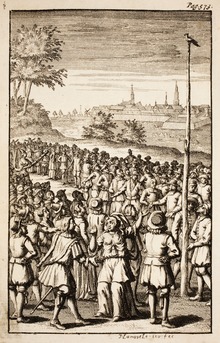
The advent of
"Have them bring as many guns as possible, for no other equipment is needed. Give strict orders that all men, even the samurai, carry guns."
— Asano Yukinaga, 1598[69]
In Ireland, Geoffrey Keating (c. 1569 – c. 1644) mentions archery as having been practiced "down to a recent period within our own memory."[70]
Early firearms were inferior in
The last regular unit armed with bows was the Archers' Company of the Honourable Artillery Company, ironically a part of the oldest regular unit in England to be armed with gunpowder weapons. The last recorded use of bows in battle in England seems to have been a skirmish at Bridgnorth; in October 1642, during the English Civil War, an impromptu militia, armed with bows, was effective against un-armoured musketmen.[76] The last use of the bow in battle in Britain is said to have occurred at the Battle of Tippermuir in Scotland on 1 September 1644, when James Graham, 1st Marquess of Montrose's Royalist highlanders defeated an army of Scottish Covenanters.[77] Among Montrose's army were bowmen.[77]
Archery continued in some areas that were subject to limitations on the ownership of arms, such as the Scottish Highlands during the repression that followed the decline of the
Within the steppe of Eurasia, archery continued to play an important part in warfare, although now restricted to mounted archery. The Ottoman Empire still fielded auxiliary cavalry which was noted for its use of bows from horseback. This practice was continued by the Ottoman subject nations, despite the Empire itself being a proponent of early firearms. The practice declined after the Crimean Khanate was absorbed by Russia; however mounted archers remained in the Ottoman order of battle until the post-1826 reforms to the Ottoman Army. The art of traditional archery remained in minority use for sport and for hunting in Turkey up until the 1920s, but the knowledge of constructing composite bows fell out of use with the death of the last bowyer in the 1930s. The rest of the Middle East also lost the continuity of its archery tradition at this time.
An exception to this trend was the
Ongoing use of bows and arrows was maintained in isolated cultures with little or no contact with the outside world. The use of traditional archery in some African conflicts has been reported in the 21st century, and the
Recreational revival
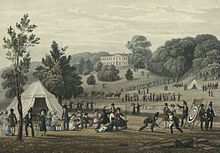
The British initiated a major revival of archery as an upper-class pursuit from about 1780–1840.[81] Early recreational archery societies included the Finsbury Archers and the Kilwinning Papingo, established in 1688. The latter held competitions in which the archers had to dislodge a wooden parrot from the top of an abbey tower. The Company of Scottish Archers was formed in 1676 and is one of the oldest sporting bodies in the world. It remained a small and scattered pastime, however, until the late 18th century when it experienced a fashionable revival among the aristocracy. Sir Ashton Lever, an antiquarian and collector, formed the Toxophilite Society in London in 1781, with the patronage of George, the Prince of Wales.
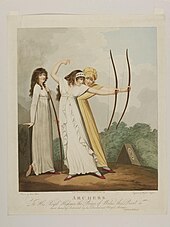
Archery societies were set up across the country, each with its own strict entry criteria and outlandish costumes. Recreational archery soon became extravagant social and ceremonial events for the nobility, complete with flags, music and
After the Napoleonic Wars, the sport became increasingly popular among all classes, and it was framed as a nostalgic reimagining of the preindustrial rural Britain. Particularly influential was Sir Walter Scott's 1819 novel, Ivanhoe that depicted the heroic character Locksley winning an archery tournament.[82]
A modern sport
The 1840s saw the first attempts at turning the recreation into a modern sport. The first

Towards the end of the 19th century, the sport experienced declining participation as alternative sports such as
In the United States, primitive archery was revived in the early 20th century. The last of the
In Korea, the transformation of archery to a healthy pastime was led by
In China, at the beginning of the 21st century, there has been revival in interest among craftsmen looking to construct bows and arrows, as well as in practicing technique in the traditional Chinese style.[88][89]
In modern times, mounted archery continues to be practiced as a popular competitive sport in modern
From the 1920s, professional engineers took an interest in archery, previously the exclusive field of traditional craft experts.[92] They led the commercial development of new forms of bow including the modern recurve and compound bow. These modern forms are now dominant in modern Western archery; traditional bows are in a minority. In the 1980s, the skills of traditional archery were revived by American enthusiasts, and combined with the new scientific understanding. Much of this expertise is available in the Traditional Bowyer's Bibles (see Further reading). Modern game archery owes much of its success to Fred Bear, an American bow hunter and bow manufacturer.[93]
See also
- Archery
- Arash
- Kyūdō, Japanese archery
- Yabusame, Japanese horseback archery
- Gungdo, Korean archery
- Turkish archery
- Chinese archery
- Archery in India
References
- ISBN 978-1-9742-6255-7.
- ^ The Handbook Of The SAS And Elite Forces. How The Professionals Fight And Win. Edited by Jon E. Lewis. p.488-Tactics And Techniques, Survival. Robinson Publishing Ltd 1997. ISBN 1-85487-675-9
- ^ S2CID 224889105.
- .
- JSTOR 40650023.
- S2CID 162438490.
- .
- S2CID 166154740.
- PMID 36812314.
- PMID 35138885.
- PMID 36812314.
- ^ Bower, Bruce (12 June 2020). "Clues to the earliest known bow-and-arrow hunting outside Africa have been found". Science News.
- PMID 32582854.
- S2CID 4462435.
- ^ "Digital photograph (colour) from Tin-Tazarift". The British Museum. Retrieved 11 November 2020.
- .
- ISBN 978-2-940347-41-4.
- JSTOR 24936943.
- ISBN 978-0-8262-1751-6.
- ISBN 1-58544-329-8.
- .
- ISBN 978-0-41533-041-1.
- S2CID 28324859. Archived from the original(PDF) on 9 July 2021.
- ISBN 978-0-500-02120-0.
- Government Printing Office. p. 484.
- Universitat Autònoma de Barcelona. 29 June 2012. Archived from the originalon 6 March 2020.
- ^ ISBN 978-0-75245-697-3.
- ISBN 978-1-84217-459-3.
- ^ Mercer, R.J. (1970). "The Neolithic Settlement on Carn Brea: Preliminary Report". Cornish Archaeology. 9. Cornwall Archaeological Society: 54–62.
- ^ Mercer, R.J. (1972). "The Excavation of the Neolithic Settlement, Carn Brea". Cornish Archaeology. 11. Cornwall Archaeological Society: 5–8.
- ISBN 978-0-22690-152-7.
- ISBN 978-0-80143-834-9.
- ISBN 978-0-7914-6364-2. Retrieved 7 January 2017.
- ^ ISBN 978-0-69104-811-6.
- .
A trilobate arrowhead can be defined as an arrowhead that has three wings or blades that are usually placed at equal angles (i.e. c. 120°) around the imaginary longitudinal axis extending from the centre of the socket or tang. Since this type of arrowhead is rare in southeastern Arabia, we must investigate its origin and the reasons behind its presence at ed-Dur.
- ISBN 978-0-04445-030-6.
- ISBN 978-0-69104-811-6.
With the bow let us win cows, with the bow let us win the contest and violent battles with the bow. The bow ruins the enemy's pleasure; with the bow let us conquer all corners of the world.
- ISBN 978-9-00412-556-8.
- ISBN 978-0-69101-758-7.
- ISBN 978-0-52126-335-1.
- ^ Kirk, Geoffrey (1993). The Iliad: A Commentary. Cambridge, UK: Cambridge University Press. p. 136.
- ISBN 8-1738-0336-6.) The clan name Gore or Gaure is also found among the modern Kambojpeople of Punjab and it is stated that the Punjab Kamboj Gaure/Gore came from the Kunar valley to Punjab at some point in time in the past. (See: Singh Dardi, Kirpal (1979). These Kamboja People. p. 122. & Singh Dardi, Kirpal (2005). Kambojas Through the Ages. p. 131.)
- Gaius Julius Caesar (1929). Rhys, Ernest (ed.). Caesar's Commentaries. Translated by W. A. Macdevitt. London, UK: Everyman's Library. Book VII, p. XXXI – via Project Gutenberg.
- ISBN 978-1-85367-303-0.
- ^ a b "Six Arts of Ancient China". Folk Archery Federation of the People's Republic of China. 8 August 2010.
- ^ ISBN 962-209-501-1.
- ^ Needham, Joseph, ed. (1986). Chemistry and Chemical Technology, Military Technology, Missiles and Sieges, Volume 5, Part 6. Science and Civilisation in China. Cambridge, UK: Cambridge University Press. pp. 124–128.
- ^ Selby, Stephen (Winter 2010). "The Bows of China". Journal of Chinese Martial Studies (2). Hong Kong: Three-In-One Press.
- ^ Griffiths, Andrew. "Archery and Social Class in Medieval England". History of Fighting.com.
- Britannica.com. 18 September 2023.
- ^ "The Bow in Medieval Warfare". Encyclopedia.com.
- ^ name="RoyalArmouries">"People of the Hundred Years' War". Royal Armouries. Archived from the original on 29 September 2022. Retrieved 28 March 2022.
- ^ name="RoyalArmouries"
- ISBN 978-1-62410-039-0.
- ^ a b c "Military Technology: The horse archer". Britannica.com.
- ^ "Mongolian Archery: from the Stone Age to Naadam". Bow International. 14 August 2020. Archived from the original on 13 April 2022. Retrieved 12 April 2022.
- ^ Griffiths, Andrew. "Mongolian Archery". History of Fighting.com.
- ^ Grayson, Charles E. & French, Mary (2004). "Korean Archery Equipment". University of Missouri Museum of Anthropology. Archived from the original on 24 June 2016.
During the Choson period (1392–1910), Korea adopted a military-service examination system from China that included a focus on archery skills and that contributed to the development of Korean archery as a practical martial art.
- Encyclopaedia Iranica. Vol. III, Fasc. 5. Encyclopædia Iranica Foundation. pp. 514–522. Retrieved 30 December 2012.
- ISBN 978-2-90407-072-3.
- ^ "Asi l Hadath – Fortified Cave". GERSL. 6 December 1989.
- ^ "Ouadi Qadisha (the Holy Valley) and the Forest of the Cedars of God (Horsh Arz el-Rab)". UNESCO.
- )
- .
- OCLC 499854155.
- ^ Faris, Nabih Amin & Elmer, Robert Potter, eds. (1945). Arab archery. An Arabic manuscript of about A.D. 1500, "A book on the excellence of the bow & arrow" and the description thereof (PDF). Princeton, NJ: Princeton University Press. Archived from the original (PDF) on 2 November 2012 – via Tuba-Archery.com. A translation of "Kitāb fī bayān fadl al-qaws w-al-sahm wa-awsāfihima," no. 793 in descriptive catalog of the Garrett collection of Arabic manuscripts in the Princeton University library.
- ^ Gallice, Henri (1903). The Art of Archery published, with Notes, from a Manuscript of the 15th Century. Translated by H. Walrond. London, UK: Horace Cox – via Archery Library.
- ISBN 978-2-21804-176-1.
- ISBN 0-85045-097-7.
- ^ Keating, Geoffrey (1908). Comyn, David & Dinneen, Patrick S. (eds.). The History of Ireland (1st ed.). London, UK: David Nutt, for the Irish Texts Society. p. 27 – via Corpus of Electronic Texts.
- ^ a b Rich, Barnabe (1574). A right exelent and pleasaunt dialogue, betwene Mercury and an English souldier contayning his supplication to Mars: bevvtified with sundry worthy histories, rare inuentions, and politike deuises. London: J. Day. Retrieved 21 April 2016.
- ISBN 978-0-52152-305-9.
- ^ Duvernay, Thomas A. & Duvernay, Nicholas Y. (2007). Korean Traditional Archery. Pohang, South Korea: Handong Global University.
- S2CID 20425600.
The mean depth of arrow wounds, for example, was an inch and a half, that of gunshot wounds six inches, not counting balls that went right through the body or head.
- ISBN 978-9-00412-498-1.
- ^ "The Garrisons of Shropshire During the Civil War, 1642–1648". Shrewsbury: Leake and Evans. 24 October 1867. p. 32 – via Google Books.
- ^ a b Fox, E.T. (15 October 2015). "Archery in the English Civil War". Fox Historical Publications. Retrieved 12 August 2019.
- ISBN 978-0-09-952055-9. First published in the USA by Alfred Knopf, 1974.
- ISBN 978-0-09-952055-9. First published in the USA by Alfred Knopf, 1974.
- ^ "Amazonian archers". BBC News. 30 May 2008. Retrieved 5 January 2010.
- ^ . Retrieved 26 March 2013.
- ^ "The Royal Company of Archers". MartinFrost.ws. Archived from the original on 25 November 2012. Retrieved 17 December 2012.
- ISBN 978-0-9645741-6-8.
- ISBN 978-0-520-24037-7.
- ^ Pope, Saxton (1925). Hunting with the Bow and Arrow. New York: G. P. Putnam's Sons.
- ^ Pope, Saxton (1926). Adventurous Bowmen: field notes on African archery. New York: G. P. Putnam's Sons.
- ISBN 978-0-96236-013-8.
- ^ "2009 Chinese Traditional Archery Seminar". Folk Archery Federation of the People's Republic of China. 2 November 2009.
- ^ "2010传统射艺研讨会在杭州举行-杭网原创-杭州网" [2010 Traditional Archery Symposium Held in Hangzhou]. Hangzhou Net (in Chinese). 30 May 2010.
- ^ "Magyar Traditional Archery". Asian Traditional Archery Research Network.
- ^ Dorji, Kunga T. & Phuntsho, Tashi. "Archery: the Real Game is Played Elsewhere". Kuensel – via Asian Traditional Archery Research Network.
- ^ Hickman, C. N.; Nagler, Forrest; Klopsteg, Paul E. (1947). Archery: The Technical Side. A compilation of scientific and technical articles on theory, construction, use and performance of bows and arrows, reprinted from journals of science and of archery. National Field Archery Association.
- ISBN 978-1-60239-046-1.
- Weitzel, Tim. "American Indian Archery Technology". The Office of the State Archaeologist, The University of Iowa. Archived from the original on 1 October 2013.
- Crombie, Laura (2016). Archery and Crossbow Guilds in Medieval Flanders. Woodbridge: Boydell and Brewer.
Further reading
- Alofs, Eduard (2014). "Studies on Mounted Warfare in Asia I: Continuity and Change in Middle Eastern Warfare, c. ce 550–1350–What Happened to the Horse Archer?". S2CID 163010878.
- Alofs, Eduard (2015). "Studies on Mounted Warfare in Asia II: The Iranian Tradition–The Armoured Horse Archer in the Middle East, c. ce 550–1350". War in History. 22 (1): 4–27. S2CID 162976652.
- Callanan, Martin (September 2013). "Melting snow patches reveal Neolithic archery". S2CID 130099119.
- Gunn, Steven (2010). "Archery practice in early Tudor England". .
- Jackson, Antoinette (2016). "A Rural Community and a Train Stop: Archery, Georgia, and the Jimmy Carter National Historic Site". Urban Anthropology and Studies of Cultural Systems and World Economic Development. 45 (3): 265–301. JSTOR 26384874.
- Johnes, Martin (April 2004). "Archery, romance and elite culture in England and Wales, c. 1780–1840". .
- Junkmanns, Jürgen; Klügl, Johanna; Schoch, Werner H.; Di Pietro, Giovanna & Hafner, Albert (December 2019). "Neolithic and Bronze Age archery equipment from alpine ice-patches: A review on components, construction techniques and functionality". Journal of Neolithic Archaeology (21): 283–314. .
- Kaegi, Walter Emil Jr. (1964). "The contribution of archery to the Turkish conquest of Anatolia". S2CID 161246352.
- Klopsteg, Paul E. (1963). A Chapter in the Evolution of Archery in America. Washington, D.C.: Smithsonian Institution.
- Laubin, Reginald (1980). American Indian Archery. University of Oklahoma Press.
- Roth, Erik (2011). With a Bended Bow: Archery in Mediaeval and Renaissance Europe. The History Press.
- Gwang Ok; Seokgyu Choi & Hee Surk Jeong (2010). "'The Disturbance of War': The Ancient Origin and Development of Korean Archery". International Journal of the History of Sport. 27 (3): 523–536. S2CID 161376479.
- Selby, Stephen (2000). Chinese Archery. Hong Kong University Press.
- Sutherland, Caroline (2001). "Archery in the Homeric epics". Classics Ireland. 8: 111–120. JSTOR 25528380.
- Wadge, Richard (2012). Archery in Medieval England: Who Were the Bowmen of Crecy?. The History Press.
- The Traditional Bowyers Bible, Volume 1. The Lyons Press. 1992. ISBN 1-58574-085-3.
- The Traditional Bowyers Bible, Volume 2. The Lyons Press. 1992. ISBN 1-58574-086-1.
- The Traditional Bowyers Bible, Volume 3. The Lyons Press. 1994. ISBN 1-58574-087-X.
- The Traditional Bowyers Bible, Volume 4. The Lyons Press. 2008. ISBN 978-0-9645741-6-8.
External links
- "Archery Library". Online Archery Books with historical content.
